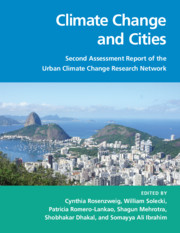Book contents
- Climate Change and Cities
- Praise for the ARC3.2 Report
- Climate Change and Cities
- Copyright page
- Contents
- UCCRN ARC3.2 List of Boxes
- Foreword – Anne Hidalgo, Mayor of Paris and Chair of C40
- Foreword – Eduardo Paes, Former Mayor of Rio de Janeiro and Former Chair of C40
- Foreword – James Nxumalo, Former Mayor of Durban
- Foreword – Joan Clos, Former Executive Secretary of UN-Habitat and Former Mayor of Barcelona
- Foreword – Christiana Figueres, Former Executive Secretary, United Nations Framework Convention on Climate Change and Vice Chair of the Global Covenant of Mayors
- Preface
- Climate Change and Cities: Second Assessment Report of the Urban Climate Change Research Network
- Introduction
- Part I Cross-Cutting Themes
- 4 Integrating Mitigation and Adaptation
- 5 Urban Planning and Urban Design
- 6 Equity, Environmental Justice, and Urban Climate Change
- 7 Economics, Finance, and the Private Sector
- Part II Urban Ecosystems and Human Services
- Part III Urban Infrastructure Systems
- Part IV Governance and Urban Futures
- Conclusion: Transforming Cities
- Annexes
- Appendices
- Index
- References
4 - Integrating Mitigation and Adaptation
Opportunities and Challenges
from Part I - Cross-Cutting Themes
Published online by Cambridge University Press: 12 April 2018
- Climate Change and Cities
- Praise for the ARC3.2 Report
- Climate Change and Cities
- Copyright page
- Contents
- UCCRN ARC3.2 List of Boxes
- Foreword – Anne Hidalgo, Mayor of Paris and Chair of C40
- Foreword – Eduardo Paes, Former Mayor of Rio de Janeiro and Former Chair of C40
- Foreword – James Nxumalo, Former Mayor of Durban
- Foreword – Joan Clos, Former Executive Secretary of UN-Habitat and Former Mayor of Barcelona
- Foreword – Christiana Figueres, Former Executive Secretary, United Nations Framework Convention on Climate Change and Vice Chair of the Global Covenant of Mayors
- Preface
- Climate Change and Cities: Second Assessment Report of the Urban Climate Change Research Network
- Introduction
- Part I Cross-Cutting Themes
- 4 Integrating Mitigation and Adaptation
- 5 Urban Planning and Urban Design
- 6 Equity, Environmental Justice, and Urban Climate Change
- 7 Economics, Finance, and the Private Sector
- Part II Urban Ecosystems and Human Services
- Part III Urban Infrastructure Systems
- Part IV Governance and Urban Futures
- Conclusion: Transforming Cities
- Annexes
- Appendices
- Index
- References
- Type
- Chapter
- Information
- Climate Change and CitiesSecond Assessment Report of the Urban Climate Change Research Network, pp. 101 - 138Publisher: Cambridge University PressPrint publication year: 2018
References
Primary Sources
Secondary Sources
- 14
- Cited by



